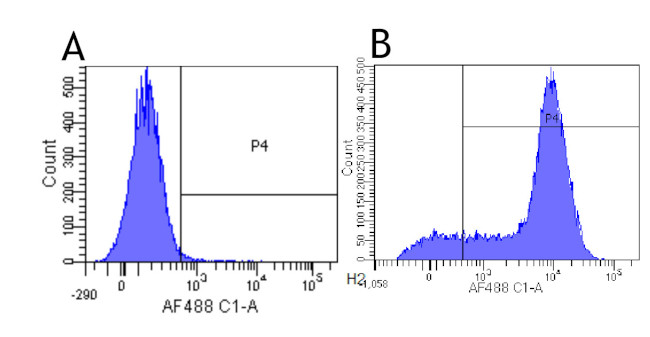Search Thermo Fisher Scientific
Invitrogen
CD44 Chimeric Recombinant Rabbit Monoclonal Antibody (Hermes-1)
FIGURE: 1 / 1
CD44 Chimeric Antibody (MA5-48017) in Flow

Product Details
MA5-48017
Species Reactivity
Host/Isotype
Expression System
Class
Type
Clone
Immunogen
Conjugate
Form
Concentration
Purification
Storage buffer
Contains
Storage conditions
Shipping conditions
RRID
Product Specific Information
Specificity: This antibody is specific for CD44 (gp90 epitope cluster I), which is selectively expressed on normal or transformed lymphoid cells that are able to recognize and bind to high endothelial venules (specialized vessels that mediate lymphocyte exit from the blood into lymphoid organs). Although this antibody was raised against human CD44, it cross-reacts with murine, rat, rabbit, primate, sheep, bovine and goat CD44.
Target Information
CD44 cell surface antigen is a 100 kDa type 1 transmembrane glycoprotein widely expressed on human leucocytes, white matter of the brain and by some epithelial cells of the intestine and breast. Several isoforms of CD44 exist, including the predominant CD44H isoform detected in many normal tissues. CD44 is a receptor for hyaluronic acid (HA) and is involved in cell-cell interactions, cell adhesion and migration. CD44 also participates in a wide variety of cellular functions including lymphocyte activation, recirculation and homing. CD44 expression may be up-regulated upon some carcinomas, and it has been speculated that this may be related to metastatic potential. CD44 is expressed by hematopoietic, non-hematopoietic cells, epithelial tissues, and to filopodia in cultured keratinocytes. Further, bone marrow myeloid cells and memory T cells express CD44 at high levels, and peripheral B and T cells can upregulate the expression of CD44 in response to certain stimulatory events. Transcripts for the CD44 gene undergo complex alternative splicing that results in many functionally distinct isoforms, however, the full-length nature of some of these variants have not been determined. Alternative splicing is the basis for the structural and functional diversity of the CD44 protein. Diseases associated with CD44 dysfunction include superficial keratitis and lichen sclerosus. CD44 also may be related to tumor metastasis formation.
For Research Use Only. Not for use in diagnostic procedures. Not for resale without express authorization.
References (0)
Bioinformatics
Protein Aliases: CD44; CD44 antigen; CD44 molecule; CD44 molecule (Indian blood group); CDw44; cell surface glycoprotein CD44; Cell surface glycoprotein CD44 (hyaluronate binding protein); cell-surface glycoprotein; chondroitin sulfate proteoglycan 8; ECMR-III; ECMRIII; Epican; Extracellular matrix receptor III; GP90 lymphocyte homing/adhesion receptor; hematopoietic cell E- and L-selectin ligand; Heparan sulfate proteoglycan; Hermes antigen; homing function and Indian blood group system; HUTCH-I; hyaluronan receptor; Hyaluronate receptor; Ly-24; Lymphocyte antigen 24; PGP I; PGP-1; PGP-I; PGPI; Phagocytic glycoprotein 1; Phagocytic glycoprotein I; sCD 44; sCD44; soluble CD 44; soluble CD44
Gene Aliases: AU023126; AW121933; AW146109; CD44; CD44A; CDW44; CSPG8; ECMR-III; HCELL; HERMES; HUTCH-I; IN; LHR; Ly-24; MC56; MDU2; MDU3; METAA; MIC4; Pgp-1; Pgp1; RHAMM
UniProt ID: (Human) Q16064, (Mouse) P15379, (Rat) P26051
Entrez Gene ID: (Human) 960, (Bovine) 281057, (Goat) 102182426, (Rabbit) 100301546, (Sheep) 101113884, (Mouse) 12505, (Rat) 25406

Performance Guarantee
If an Invitrogen™ antibody doesn't perform as described on our website or datasheet,we'll replace the product at no cost to you, or provide you with a credit for a future purchase.*
Learn more
We're here to help
Get expert recommendations for common problems or connect directly with an on staff expert for technical assistance related to applications, equipment and general product use.
Contact tech support
